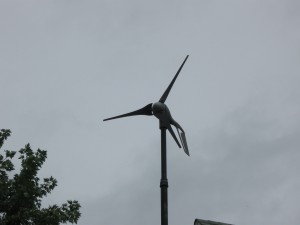Alternative Energy – The Wind
I have been interested the last few years by alternative energy. This isn’t a tree hugging thing, it’s more of a interest in saving myself money. I have started looking into this more and more, and have myself purchased solar panels for some small scale testing around my house. I started this series off with the one that originally got my interest into home energy production. I will get into some wind power history, and then will go into practical applications as the series progresses.
Wind Energy – As long as 1000 BC, mankind has harnessed the wind to help him in his tasks. Pumping water was used in grain grinding and water pumping. This helped to automate these tasks. Many of the earliest blades on the wind mill were made of reeds or wood.
The smaller wind powered mechanical pumps that dotted the plains and most farms until the electrical grid made it to every level of the farm. Those famous windmills of the plain are still in use in some places, but are much less common to see now than even 20 years ago. Between 1850 and 1970, over 6 million mechanical output wind machines had been installed in the US, with the main purpose being to water the stock, and to provide water to the home.
By the late 19th century, a multi-blade windmill design that was successful in America was used to generate electricity.
So why have wind generators been so slow to take off? This cost and efficiency have played a major role in their slow adoption until recent history. The rising cost of electricity and the more efficient designs of today that use modified propellers to drive the turbine shafts. A home is now able to generate and store its power in this way until the consumer or user needs it. These new designs are showing up on homes here and there around Iowa as cost is now not a major factor, and their users find that having electricity available to them even during times that the electric grid may fail such as in storms or other disasters offers a sense of security.
Today we are now use to seeing those large white windmills gracefully spinning in the distance turning out power to the masses. Again, the rising cost of fossil fueled energy has risen far enough that generating from the wind has become a cheaper and now fashionable way to generate electricity. Spirit Lake installed a 250-kW wind turbine at their elementary school, and it provides on average of 350,00 kWh of electricity to them over the year. More than is necessary at their 53,000 square foot facility. The excess has then been sold back to the grid earning the school $25,000 in 5 years. The school district found this so successful that they are now building another one, this with the capacity of 750 kW. A kilowatt-hour means one kilowatt (1,000 watts) of consumed or produced electricity over 1 hour. So, if you were to leave that 100 watt light turned on in the living room for 10 hours that would be 1 kWh of electricity.
So imagine that every person in Oskaloosa started generating their own electricity. How long would it take for you to pay off the cost? With the looming energy tax legislation on the horizon, and a population that has started to look more at being self sufficient the cost until one breaks even could be just a few years. But even more than knowing that you’re helping yourself, you also have that sense of being secure in the knowledge that if during times of emergency you would have the capability to provide lighting, and refrigeration and for communication.
I asked this question of some local residents that have a wind generator, and they purchased it mostly for that sense of security during times of need, they combined the wind generator alongside solar panels as well to provide the most of their potential energy production. And the money saved by doing this all the more bonus.
Next time I will write about solar production, and then show real world applications and uses to help make the transition to alternative power sources less geeky and intimidating.

















